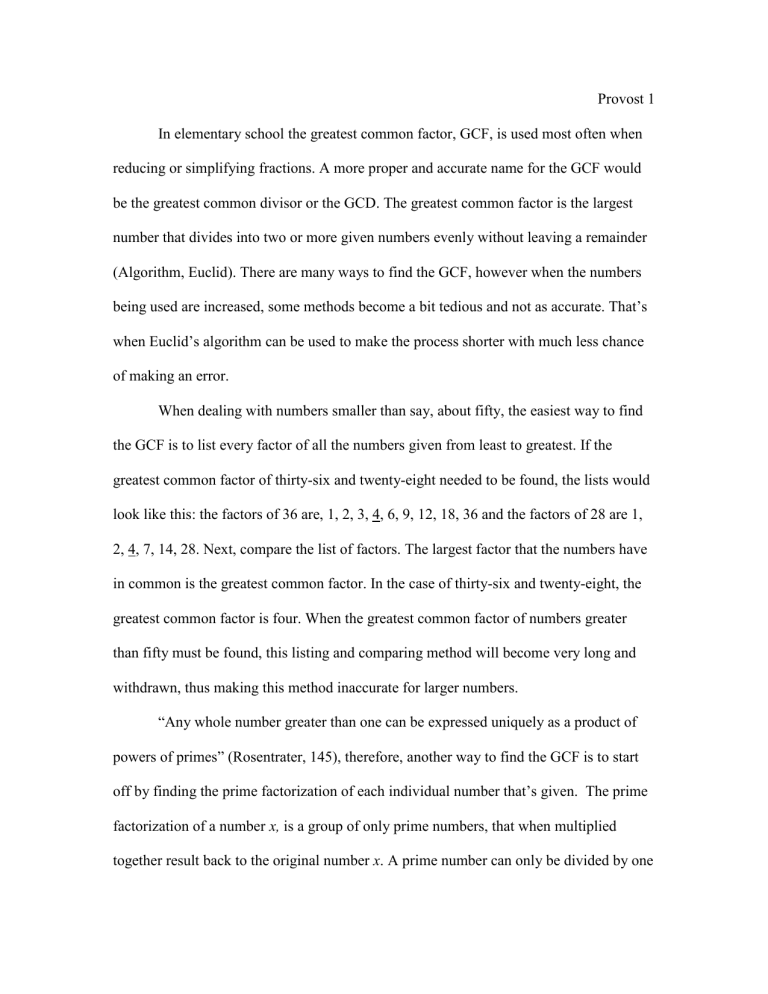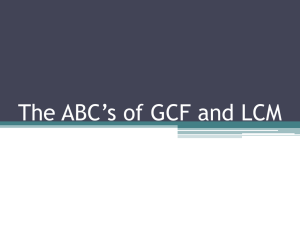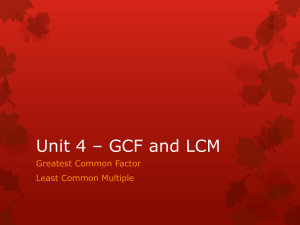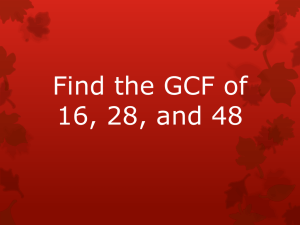GCF

Provost 1
In elementary school the greatest common factor, GCF, is used most often when reducing or simplifying fractions. A more proper and accurate name for the GCF would be the greatest common divisor or the GCD. The greatest common factor is the largest number that divides into two or more given numbers evenly without leaving a remainder
(Algorithm, Euclid). There are many ways to find the GCF, however when the numbers being used are increased, some methods become a bit tedious and not as accurate. That’s when Euclid’s algorithm can be used to make the process shorter with much less chance of making an error.
When dealing with numbers smaller than say, about fifty, the easiest way to find the GCF is to list every factor of all the numbers given from least to greatest. If the greatest common factor of thirty-six and twenty-eight needed to be found, the lists would look like this: the factors of 36 are, 1, 2, 3, 4, 6, 9, 12, 18, 36 and the factors of 28 are 1,
2, 4, 7, 14, 28. Next, compare the list of factors. The largest factor that the numbers have in common is the greatest common factor. In the case of thirty-six and twenty-eight, the greatest common factor is four. When the greatest common factor of numbers greater than fifty must be found, this listing and comparing method will become very long and withdrawn, thus making this method inaccurate for larger numbers.
“Any whole number greater than one can be expressed uniquely as a product of powers of primes” (Rosentrater, 145), therefore, another way to find the GCF is to start off by finding the prime factorization of each individual number that’s given. The prime factorization of a number x, is a group of only prime numbers, that when multiplied together result back to the original number x . A prime number can only be divided by one
Provost 2 and itself. Therefore the only factors of a prime number p , are 1 and p, thus the greatest common factor of a prime number will always be itself. The list of the first ten prime numbers includes: 2, 3, 5, 7, 11, 13, 17, 19, 23, and 29 (Pierce, Rod). To find the GCF of
56 and 72 using the prime factorization method, first divide each original number by some lesser prime number. Seven is a prime number and is a factor of fifty-six, so one could start by dividing fifty-six by seven. Fifty-six divided by seven equals eight. Now break down eight, the none prime number, into it’s prime factorization. Eight divided by two, which is also a prime number, equals four. Repeat again the same thing with the non prime number. Break down four into it’s prime factorization. Four divided by two equals two. Now all the numbers that are left are prime (2∙2∙2∙7), and are therefore only factors of themselves and can’t be broken down any further. All the prime numbers that were divided into the preceding quotients make up the prime factorization of fifty-six. Fifty-six in it’s prime factorization form equals 2 3 ∙7. The same procedure is then done with seventy-two. Three is a prime number and divides into seventy-two, twenty-four times.
Twenty-four is also divisible by three and 24÷3=8. Eight is then broken down into 4∙2 and four is broken down into 2∙2. All the prime numbers are then multiplied together to make the prime factorization of seventy-two, (2∙2∙2∙3∙3). The prime factorization of seventy-two equals 2 3 ∙ 3 2
. The factor trees are sometimes a better visual representation.
56 72
/\ /\
7 8 = 2 3 ∙7
3 24
/\ /\
2 4 3 8 = 2 3 ∙ 3 2
/\ /\
2 2 2 4
/\
2 2
Provost 3
The final step to finding the GCF is to compare all the prime factors the two numbers have in common. Since fifty-six and seventy-two both have the factor two in common that’s the number that will be looked at. Since fifty-six and seventy-two both have 2 3 included in their prime factorization, 2 3
will be the prime numeral used in the prime factorization. If the base two numerals included in both original prime factorizations had different exponents the base numeral with the smaller exponential number would have been used. The exponents in this case were the same, so 2 3 or eight is therefore the GCF of both numbers.
Listing the factors and forming the prime factorizations are the two most taught and used forms of finding the greatest common factor, however, when numbers increase into the hundreds, thousands, or higher, these methods become even more inaccurate and long. Euclid invented a method to finding the GCF of two numbers that takes no more division steps than five times the number of digits (base 10) of the smaller integer
(Algorithm, Euclid). Euclid’s algorithm was originally a series of subtraction problems:
“But, if CD does not measure AB, then, the less of the numbers AB, CD being continually subtracted from the greater, some number will be left which will measure the one before it” (Euclid, 298). Euclid’s algorithm states: “Let AB, CD be the two given numbers not prime to one another. Thus it is required to find the greatest common measure of AB, CD. If now CD measures AB—and it also measures itself—CD is a common measure of CD, AB” (Euclid, 298). In other words, if AB|CD, then
GCF(CD,AB)=CD (Bogomolny). “Next, like the text-books of algebra, he goes on to show that d will be some common measure of a, b.
For d measures c; therefore it measure qc+d, that is, b, and hence it measures pb+c, that is, a” (Euclid, 299). In other words, if
Provost 4 a=bt+r for integers t and r then GCF( a,b )=GCF( b,r ) (Bogomolny). “Indeed, every common divisor of a and b also divides r. Thus gcd( a, b ) divides r . But, of course, gcd( a, b )| b . Therefore, gcd( a, b ) is a common divisor of b and r and hence gcd( a, b
) ≤ gcd( b, r ).
The reverse is also true because every divisor of b and r also divides a
” (Bogomolny).
Since 300 B.C, when Euclid developed this algorithm, it has been altered to a series of division problems that result in quotients and remainders. Let a be the larger of x and y and let b be the smaller of the two, ( r stands for the remainder and q stands for the quotient). First find a multiple of b to get a=qb+r . If r≠0
replace a by r and repeat from
1. If r=0 , the GCF( a,b )= b (Rosentrater, 169). A visual example of Euclid’s algorithm may also be very helpful.
Let a = 2322, b = 654.
2322 = 654·3 + 360 GCF(2322, 654) = GCF(654, 360)
654 = 360·1 + 294 GCF(654, 360) = GCF(360, 294)
360 = 294·1 + 66 GCF(360, 294) = GCF(294, 66)
294 = 66·4 + 30
GCF(294, 66) = GCF(66, 30)
66 = 30·2 + 6
GCF(66, 30) = GCF(30, 6)
30 = 6·5 GCF(30, 6) = 6
Therefore, GCF(2322,654) = 6. (Bogomolny)
When carrying out Euclid’s algorithm the smaller number, in this case b, is divided into the larger number a , the remainder is then added on to the end of the sequence. The remainder then replaces the larger number in GCF( a,b ). The smaller number is again divided into the larger and the remainder is added. The remainder again will replace the larger number in GCF( a,b ). This process is repeated until the remainder of a and b equals
0. The last factor of a and b that resulted with a remainder of 0 is the greatest common factor of a and b.
Provost 5
The least common multiple, LCM, is essentially the opposite of the greatest common factor. “Given two whole numbers
x and y , the least common multiple of x and y is the smallest nonzero whole number m divisible by both x and y . We write m =LCM( x,y
)” (Rosentrater, 165). Instead of finding the factors of x and y we are finding all the numbers that x and y are factors of. Like the GCF, the LCM can be found by listing all the multiples of the two given numbers, x and y . If x =56 the list would look like this: 56, 112, 168, 224, 280, 336, 392, 448, and 504. Fifty-six is multiplied by each increasing numeral until you have found a multiple in common with y. Then, if y =72 the list of multiples would be: 72, 144, 216, 288, 360, 432, and 504. Since 504 is the first multiple that fifty-six and seventy-two are both a factor of, 504 is the least common multiple of fifty-six and seventy-two.
Since, every whole number greater than 1 is either a prime number or has a prime factor (Rosentrater, 152) the LCM can also be found, like the GCF, by constructing the original numbers x and y into their prime factorization form. Take the same numbers used in the GCF example, 56 and 72. Fifty-six in prime factorization form is 2 3 ∙7, as found above, and Seventy-two in prime factorization form is 2 3 ∙ 3 2
. However, when finding the
LCM every prime number that the factorizations contain, whether in common or not, are multiplied together. If both numerals have a prime number in common, only one numeral should be used to find the LCM. If two common base numerals have different exponents take the numeral containing the highest exponential power, opposite from finding the
GCF. The least common multiple will equal all these primes multiplied together. Fifty-six and seventy-two have a LCM of 2 3 ∙ 3 2 ∙7=504.
Provost 6
By using Euclid’s Algorithm the LCM can also be found if the GCF is known or found first. If LCM( x,y
)∙GCF( x,y )= x∙y
, then LCM( x,y )= 𝑥∙𝑦
𝐺𝐶𝐹(𝑥,𝑦)
(Rosentrater, 168). If the least common multiple of 82 and 96 needed to be found, the easiest and most efficient way is to start off by finding the greatest common factor of eighty-two and ninety-six.
GCF(96,82) 96=82∙1+14 =GCF(82,14)
GCF(82,14) 82=14∙5+12 =GCF(14,12)
GCF(14,12) 14=12∙1+2 =GCF(12,2)
GCF(12,2) 12=2∙6+0 =GCF(2,0)
GCF(2,0)
GCF(96,82)=2 𝑥∙𝑦
Next plug the greatest common factor into the equation LCM( x,y )=
𝐺𝐶𝐹(𝑥,𝑦)
. So
82∙96
LCM(82,96)=
𝐺𝐶𝐹(82,96)
=
82∙96
2
=
7,872
2
=3,936. Using the listing method or prime factorization method to find the LCM(82,96) would have taken much longer and possibly been inaccurate. Knowing how to find the greatest common factor can be key to the success of finding the least common multiple as well.
Finding the GCF and LCM can be as easy as using the listing method or finding the prime factorization. However, when dealing with large numbers, Euclid’s algorithm can be used as an easy and accurate method. Euclid’s algorithm is the oldest algorithm that is still in use today. It has been used by others to create new numbering systems as well as other high level mathematical concepts such as: Stern-Brogot base tree, Chinese remainder theorem, Sturm chain, and the Bezout’s identity (Algorithm, Euclid).
Provost 7
Bibliography
A. Bogomolny, Euclid's Algorithm from Interactive Mathematics Miscellany and
Puzzles <http://www.cut-the-knot.org/blue/Euclid.shtml>, Accessed 15 November 2011
Euclid. The thirteen books of Euclid’s Elements. Vol. 2. Trans. Thomas L. Heath.
New York: Dover Publications, Inc, 1956.
“Euclidean Algorithm.” 13, Nov. 2011. Wikipedia Foundation, Inc. 15 November
2011. <http://en.wikipedia.org/wiki/Euclidean_algorithm>
Pierce, Rod. "Math is Fun - Maths Resources" Math Is Fun. Ed. Rod Pierce. 11
Sep 2011. 16 Nov 2011 <http://www.mathsisfun.com/index.htm>
Rosentrater, Ray C. Fundamental of Mathematics I. Westmont College. Fall 2011








